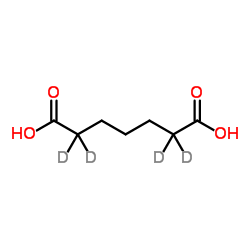(2,2,6,6-2H4)Heptanedioic acid
Modify Date: 2024-01-11 22:12:33

(2,2,6,6-2H4)Heptanedioic acid structure
|
Common Name | (2,2,6,6-2H4)Heptanedioic acid | ||
|---|---|---|---|---|
| CAS Number | 19031-56-2 | Molecular Weight | 164.192 | |
| Density | 1.2±0.1 g/cm3 | Boiling Point | 353.7±25.0 °C at 760 mmHg | |
| Molecular Formula | C7H8D4O4 | Melting Point | N/A | |
| MSDS | N/A | Flash Point | 181.9±19.7 °C | |
Use of (2,2,6,6-2H4)Heptanedioic acidPimelic acid-d4 is the deuterium labeled Pimelic acid[1]. Pimelic acid is the organic compound and its derivatives are involved in the biosynthesis of the amino acid called lysine. |
| Name | heptanedioic-2,2,6,6-d4 acid |
|---|---|
| Synonym | More Synonyms |
| Description | Pimelic acid-d4 is the deuterium labeled Pimelic acid[1]. Pimelic acid is the organic compound and its derivatives are involved in the biosynthesis of the amino acid called lysine. |
|---|---|
| Related Catalog | |
| In Vitro | Stable heavy isotopes of hydrogen, carbon, and other elements have been incorporated into drug molecules, largely as tracers for quantitation during the drug development process. Deuteration has gained attention because of its potential to affect the pharmacokinetic and metabolic profiles of drugs[1]. |
| References |
| Density | 1.2±0.1 g/cm3 |
|---|---|
| Boiling Point | 353.7±25.0 °C at 760 mmHg |
| Molecular Formula | C7H8D4O4 |
| Molecular Weight | 164.192 |
| Flash Point | 181.9±19.7 °C |
| Exact Mass | 164.098663 |
| PSA | 74.60000 |
| LogP | 0.27 |
| Vapour Pressure | 0.0±1.7 mmHg at 25°C |
| Index of Refraction | 1.476 |
| (2,2,6,6-H)Heptanedioic acid |
| 2,2,6,6-Tetrachlorcyclohexanon |
| 2,2,6,6-tetrachloro-cyclohexanone |
| 2,2,6,6-Tetrachlorocyclohexanon |
| Heptanedioic-2,2,6,6-d acid |
| 2,2,6,6-tetradeuterio-heptanedioic acid |